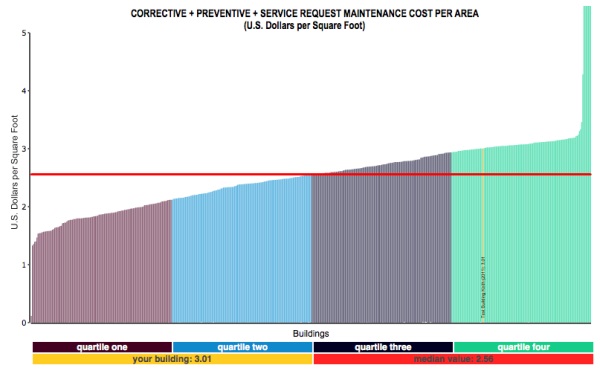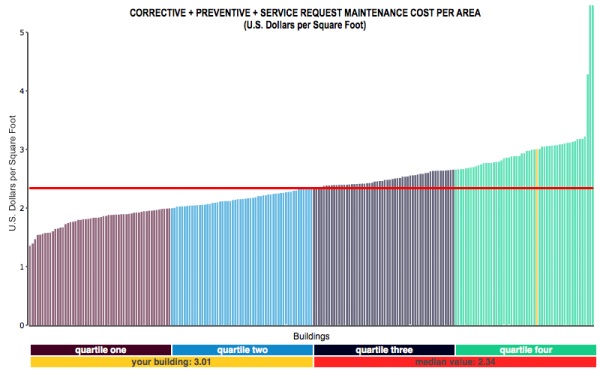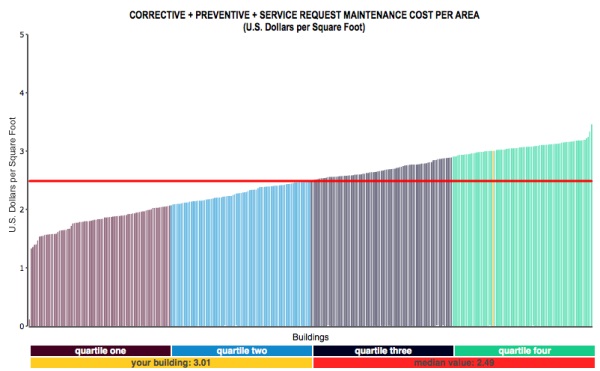Maintenance costs are usually either the first or second largest cost component for most FMs. FMs are looking for options that would improve the efficiency of their maintenance organization, usually to improve the overall maintenance levels and sometimes to reduce costs. Many FMs participate in benchmarking programs only to find that they have difficulty developing good comparisons for their facility type. Having access to ample data with good filter sets is key to making the right comparisons. Below are a few examples showing the value that filters can add to the analysis of your benchmarking data.
In the first example, if you are comparing your facility’s maintenance costs you might not know which filters are the most relevant. Let’s see how to determine which ones make a difference.
First, we’ll look at whether the size of a facility impacts maintenance costs. Our building is about 1.3 million GSF; since we believe that larger facilities may have a scale factor that results in lower costs, we may want to look at just facilities that are larger than 600,000 GSF (see Figure 1).

Filters: Type of facility: office; Size: greater than 600,000 GSF
Provided courtesy of FM BENCHMARKING
The median cost is $2.56 per gross square foot with a sample size of 500 buildings. Our facility is shown in yellow (near the beginning of the fourth quartile) and has a maintenance cost of $2.96 per GSF.
Since our building is fairly new (6 years old), what happens to our ranking if we now add an age filter, comparing our costs not only to only larger (>600,000 GSF) buildings, but also newer buildings, those with an age of 4-10 years (see Figure 2)?

Filters: Type of facility: office; Size: greater than 600,000 GSF; Age: 4-10 years
Provided courtesy of FM BENCHMARKING
We would expect the cost of newer facilities to be less and the data agrees with that assumption. According to this filter the median cost of buildings with an age of 4-10 years is indeed less (from $2.56 down to $2.34); thus, by comparing our building to both large and new buildings, we see that and our relative ranking is a little poorer, now in the middle of the fourth quartile (instead of near the left/beginning of the fourth quartile).
In the next example, we take the same facility and same filters but add the number of shifts per week as a filter. Our building operates 15 shifts per week (Monday — Friday, 3 shifts per day). We’d expect buildings with so many shifts to cost a bit more to operate than those open for just 5 shifts a week (see Figure 3).

Filters: Type of facility: office; Size: greater than 600,000 GSF; Age: 4-10 years; Shifts: 8-16 per week
Provided courtesy of FM BENCHMARKING
There are 338 facilities that match these filter criteria which is still a very adequate sample size for good comparisons. Sure enough, we see that the median cost, with the 8-16 shifts filter, did indeed increase—to $2.49 per GSF. Accordingly, our building now has shifted a bit to the left, to reflect the changes from this filter.
We think through what else may be increasing our maintenance costs (to make our numbers so much higher than the norm), and can’t think of any other filters to apply. We therefore are satisfied that we have an accurate comparison.
Sadly, we come to the conclusion that our building is costing more to maintain that other comparable buildings, and it’s clear we need to do something about it. Our next step is to review our maintenance program and see if there are any practices that we should modify to reduce our maintenance costs.
For example, some benchmarking tools will enable you to compare your preventive and corrective maintenance costs. We then may determine that our corrective maintenance costs occupy a larger percentage of total maintenance than most other buildings’ corrective maintenance costs. So we may want to budget more funds for preventive maintenance, as we know that likely will bring down the corrective maintenance costs more than we spend on the preventive maintenance. And now, through the benchmarking tool, we have proof.
Some benchmarking applications, including FM BENCHMARKING (from where the above examples came) actually allow you to benchmark the best practices so you can see not only how your building compares to others, but which best practices have been implemented by the better-performing buildings. You then get the data to justify what you may need to change to bring your maintenance costs more in line with others.
Conclusions
Some things we’ve learned from applying various filters in our example that may affect management focus:
- Our costs are in the high range
- The multi-shift filter is a good one to use since the facility operating continuously during the week.
- We should examine the maintenance functions provided and determine what is contributing to the high cost profile.
As you can see filters are powerful tools to enhance your benchmarking value. By applying filters that are appropriate to the benchmarking metrics under consideration you can enhance the value of the process and be sure you are making valid comparisons.